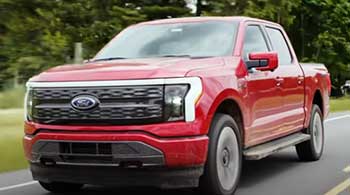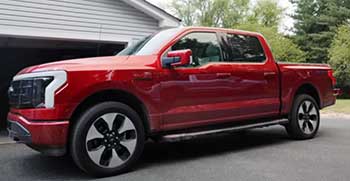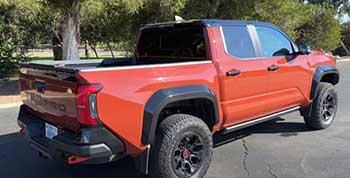
I’ve always been a truck guy. There’s something about the rumble of an engine, the promise of adventure, and the sheer utility of a pickup that gets my blood pumping.
So, when I set out to compare the 2025 Ford F-150 and the 2025 Toyota Tacoma, I wanted to experience both trucks firsthand to see which one truly fits my lifestyle—and maybe yours too.
This article is my journey through their features, strengths, and quirks, with a detailed look at their pros and cons, a comparison table, and practical maintenance tips.
My goal is to help you decide which truck suits your needs, whether you’re hauling heavy loads or cruising backroads.
Comparison Table
| Feature | Ford F-150 (2025) | Toyota Tacoma (2025) |
|---|---|---|
| Base MSRP | $39,645 | $33,185 |
| Engine Options | 2.7L V6 (400 hp), 3.5L V6 Hybrid (430 hp), etc. | 2.4L 4-cylinder (228 hp), 2.4L Turbo (278 hp) |
| Towing Capacity | Up to 14,000 lbs | Up to 6,800 lbs |
| Payload Capacity | Up to 3,270 lbs | Up to 1,620 lbs |
| Fuel Economy | 20/24 MPG (city/highway, non-hybrid) | 20/26 MPG (city/highway) |
| Cab Configurations | Regular, SuperCab, SuperCrew | Access Cab, Double Cab |
| Bed Lengths | 5.5, 6.5, 8.0 ft | 5.0, 6.0 ft |
| Reliability Rating | 8.7/10 (iSeeCars) | 9.2/10 (iSeeCars) |
| Safety Rating | 4.79/5 (NHTSA) | 4/5 (NHTSA) |
| Infotainment | SYNC 4, 12-inch touchscreen | 8-inch or 14-inch touchscreen |
| Off-Road Trims | Raptor, Tremor | TRD Pro, Trailhunter |
My Experience With the Ford F-150
I slid into the driver’s seat of the 2025 Ford F-150, and immediately, I felt like I was commanding a beast. This full-size pickup is America’s best-selling truck for a reason—it’s a powerhouse built for those who need to haul, tow, or just feel unstoppable.
My test drive took me through city streets, highways, and a rugged off-road trail near my hometown. The F-150’s interior felt like a cockpit, with its massive 12-inch SYNC 4 touchscreen and plush leather seats in the Lariat trim. The cabin was roomy, perfect for my 6’2” frame, and the rear seats had enough legroom for my buddies to stretch out comfortably.
On the road, the F-150’s 2.7-liter EcoBoost V6 delivered 400 horsepower with a smoothness that surprised me. It tackled steep inclines and heavy loads like they were nothing. I hitched a trailer to test its towing capacity, which maxes out at an impressive 14,000 pounds when properly equipped.
The Pro Trailer Backup Assist made reversing with a trailer feel like cheating—it’s a game-changer for anyone who’s ever struggled with that task. Off-road, the Raptor trim I tried later was a beast, with its 35-inch tires and skid plates eating up rocky terrain.
But it wasn’t all perfect. The F-150’s size made parking in tight city spots a hassle, and I noticed the fuel economy, even with the hybrid option, wasn’t as stellar as I’d hoped for daily commuting.
Still, the sheer versatility of cab and bed configurations—Regular, SuperCab, or SuperCrew with bed lengths from 5.5 to 8 feet—gave me options to tailor the truck to my needs, whether I was hauling tools or camping gear.
Also read: My Thoughts on Ford Edge Vs. Hyundai Tucson.
My Experience With the Toyota Tacoma
Next, I hopped into the 2025 Toyota Tacoma, a midsize pickup with a reputation for reliability and off-road prowess. The moment I started the engine, I could tell this truck was built for agility.
Its smaller footprint made it a breeze to navigate through urban streets and tight parking lots. The Tacoma’s interior, while not as luxurious as the F-150’s higher trims, was functional and modern, especially with the optional 14-inch touchscreen in the TRD Pro model. The seats were comfortable, but I noticed the back row was a bit cramped for taller passengers.
The Tacoma’s 2.4-liter turbocharged four-cylinder engine, pumping out 278 horsepower in the higher trims, felt peppy enough for most tasks, but it lacked the raw power of the F-150.
I took it on the same off-road trail, and the TRD Pro’s Multi-Terrain Select system and Crawl Control made it feel like a mountain goat, nimbly tackling narrow paths and rocky climbs. Towing was less impressive, capping at 6,800 pounds, which is fine for smaller trailers but can’t compete with the F-150’s muscle.
What stood out was the Tacoma’s reliability vibe. I’ve heard stories from friends who’ve driven their Tacomas for over 200,000 miles with minimal issues, and that legacy carries weight. However, the engine felt underpowered when I pushed it hard, and the ride was noisier than the F-150’s, especially on the highway.
Pros of the Ford F-150

- Unmatched Towing and Payload: The F-150 can tow up to 14,000 pounds and carry a payload of 3,270 pounds, making it ideal for heavy-duty tasks like hauling boats or construction equipment. I towed a 10,000-pound trailer with ease, and the truck barely broke a sweat.
- Powerful Engine Lineup: With options like the 2.7L EcoBoost V6 (400 hp) and the 3.5L PowerBoost Hybrid (430 hp), the F-150 offers a range of powertrains to suit any need. I loved the hybrid’s balance of power and slightly better fuel economy.
- Spacious and Luxurious Interior: The SuperCrew cab is massive, with 40.8 inches of rear legroom. The Lariat and Platinum trims felt like luxury SUVs, with leather seats and a quiet cabin that made long drives a pleasure.
- Advanced Tech Features: The SYNC 4 system with a 12-inch touchscreen is intuitive, supporting Apple CarPlay and Android Auto. The BlueCruise hands-free driving tech was a standout, letting me relax on highways.
- Versatile Configurations: Three cab styles and three bed lengths (5.5, 6.5, or 8 feet) let you customize the F-150 for work or play. I appreciated the 50.6-inch-wide bed for fitting oversized gear.
- Off-Road Prowess: The Raptor and Tremor trims come with skid plates, all-terrain tires, and drive modes like Rock Crawl. I felt invincible tackling muddy trails in the Raptor.
Cons of the Ford F-150
- Higher Price Tag: Starting at $39,645, the F-150 is pricier than the Tacoma, and top trims like the Raptor can exceed $70,000. I winced at the cost of fully loaded models.
- Fuel Economy Could Be Better: Even the hybrid gets 25/25 MPG (city/highway), which isn’t great for daily commuting. My city drives averaged closer to 20 MPG.
- Size Can Be a Hassle: At 209 inches long and 79 inches wide, the F-150 is tough to park in urban areas. I struggled to fit it into tight spaces at the mall.
- Reliability Concerns: While improved, the F-150’s reliability rating (8.7/10) trails the Tacoma’s (9.2/10). I’ve read about past issues with EcoBoost engines, which gave me pause.
- Complex Maintenance: Turbocharged engines and hybrid systems can mean higher repair costs. A friend mentioned a $1,200 bill for an EcoBoost turbo issue, which isn’t cheap.
- Learning New Tech: The abundance of tech, like Pro Trailer Backup Assist, takes time to master. I fumbled with the system initially, though it got easier with practice.
Maintenance Tips for the Ford F-150
- Regular Oil Changes: The F-150’s EcoBoost engines demand high-quality synthetic oil every 5,000–7,500 miles. I stick to Ford’s recommended 5W-30 to keep the turbos happy.
- Tire Rotations and Alignment: With its heavy-duty capabilities, tire wear can be uneven, especially off-road. Rotate tires every 6,000 miles and check alignment annually to avoid costly replacements.
- Check Transmission Fluid: The 10-speed automatic is smooth but sensitive. I check fluid levels every 30,000 miles and replace them per Ford’s schedule (around 60,000 miles) to prevent gear hunting.
- Battery Maintenance: The hybrid models have complex battery systems. Keep terminals clean and check the 12-volt battery yearly, as I learned a weak battery can cause hybrid system errors.
- Inspect Brakes and Suspension: Heavy towing puts stress on brakes and shocks. I inspect brake pads every 20,000 miles and replace shocks if I notice a rougher ride, especially on Raptor models.
- Clean Air Filters: Off-roading clogs air filters fast. I replace mine every 15,000 miles or after dusty trails to maintain engine efficiency and fuel economy.
Pros of the Toyota Tacoma
- Legendary Reliability: The Tacoma’s 9.2/10 reliability rating is hard to beat. Friends with older models swear by their 200,000-mile longevity with minimal repairs.
- Better Fuel Economy: With 20/26 MPG (city/highway), the Tacoma sips less fuel than the F-150, saving me a few bucks on daily commutes.
- Compact and Agile: At 212 inches long and 74 inches wide, the Tacoma is easier to park and maneuver in tight spaces. I zipped through city streets with no stress.
- Off-Road Capability: The TRD Pro and Trailhunter trims shine with Crawl Control and Multi-Terrain Select. I tackled narrow trails effortlessly, feeling like a pro.
- Strong Resale Value: The Tacoma retains 77.6% of its value after five years, compared to the F-150’s 62.1%. This made me feel better about long-term costs.
- Simpler Maintenance: With fewer complex systems, repairs are often cheaper. A mechanic buddy quoted $400 less for a Tacoma brake job than an F-150’s.
Cons of the Toyota Tacoma
- Limited Towing and Payload: Capped at 6,800 pounds towing and 1,620 pounds payload, the Tacoma struggles with heavy loads. I couldn’t tow my friend’s boat easily.
- Underpowered Engines: The 2.4L engines (228 or 278 hp) feel sluggish compared to the F-150. I had to floor it to merge onto highways.
- Cramped Rear Seating: The Double Cab’s 32.6 inches of rear legroom felt tight for my taller friends, who complained on longer trips.
- Noisier Ride: The cabin is louder than the F-150’s, especially at highway speeds. I noticed more road noise during my test drive.
- Fewer Luxury Features: Even top trims lack the F-150’s high-end touches like BlueCruise or massaging seats. The interior felt more utilitarian.
- Limited Cab/Bed Options: Only two cab styles and two bed lengths (5 or 6 feet) restrict versatility. I wished for more customization for my gear.
Maintenance Tips for the Toyota Tacoma

- Oil and Filter Changes: Use 0W-20 synthetic oil every 7,500–10,000 miles. I’ve found this keeps the 2.4L engine running smoothly and boosts fuel efficiency.
- Check Differential Fluid: The 4WD system needs clean fluid every 30,000 miles, especially for off-roading. I check it yearly to avoid wear on gears.
- Rotate Tires Regularly: The Tacoma’s off-road trims chew through tires on rough terrain. I rotate every 6,000 miles to ensure even wear.
- Inspect Brake System: Drum brakes on base models need checking every 20,000 miles. I upgrade to disc brakes on higher trims for better stopping power.
- Clean and Lubricate Joints: Off-road dust can gum up suspension joints. I clean and lube them every 15,000 miles to maintain a smooth ride.
- Monitor Cooling System: The radiator and coolant need checking every 30,000 miles. I flush the system every 60,000 miles to prevent overheating.
Read more: My Thoughts on GMC Terrain Vs. Ford Escape.
Comparison with Other Brands
- Chevrolet Silverado 1500: The Silverado matches the F-150’s towing (up to 13,300 lbs) but feels less refined. Its interior isn’t as plush, and the ride is stiffer than the F-150’s, though it’s cheaper than top F-150 trims. Compared to the Tacoma, it’s overkill for light tasks but lacks the Tacoma’s nimble handling.
- Ram 1500: The Ram 1500’s air suspension gives a smoother ride than the F-150, and its Uconnect system rivals SYNC 4. However, its reliability (8.5/10) trails both trucks, and its towing (12,750 lbs) is slightly less than the F-150’s. It’s too big for Tacoma fans.
- Toyota Tundra: The Tundra, Toyota’s full-size truck, tows up to 12,000 lbs, outpacing the Tacoma but not the F-150. Its reliability (9.0/10) is strong, but it’s pricier than the Tacoma and less luxurious than the F-150’s top trims. I found it a middle ground.
- Nissan Frontier: The Frontier’s 310 hp V6 beats the Tacoma’s power but not the F-150’s. Its towing (6,720 lbs) is similar to the Tacoma’s, but it lacks the Tacoma’s off-road finesse and resale value. I found its interior dated compared to both.
- GMC Sierra 1500: The Sierra’s upscale Denali trim rivals the F-150’s Platinum but costs more. Its towing (13,200 lbs) is close to the F-150’s, but its reliability (8.6/10) is lower. It’s less agile than the Tacoma for urban driving.
- Ford Ranger: The Ranger, a midsize like the Tacoma, tows up to 7,500 lbs and feels sportier. Its reliability (8.8/10) is solid but not Tacoma-level, and it’s less luxurious than the F-150. I liked its balance but preferred the Tacoma’s off-road edge.
Frequently Asked Questions (FAQ)
The Tacoma edges out with a 9.2/10 reliability rating from iSeeCars, compared to the F-150’s 8.7/10. Its simpler design means fewer repairs.
The F-150 is better for heavy towing (14,000 lbs vs. Tundra’s 12,000 lbs) and luxury features. The Tundra is more reliable (9.0/10) but less versatile.
Toyota trucks, especially the Tacoma, are generally more reliable (9.2/10 vs. Ford’s 8.7/10 for the F-150). Toyota’s simpler designs lead to fewer issues.
It depends on your needs. Ford’s F-150 excels in power, towing, and tech, while Toyota’s Tacoma shines in reliability, fuel efficiency, and maneuverability.
Conclusion: For Ford F-150 or Toyota Tacoma
You’re probably wondering which truck I’d pick after spending time with both. Honestly, it’s a tough call because the 2025 Ford F-150 and Toyota Tacoma cater to different vibes. If you need a truck that’s a jack-of-all-trades—towing massive loads, offering luxury, and dominating off-road trails—the F-150 is your beast.
Its power, tech, and versatility make it perfect for heavy-duty work or long family trips. But if you want a nimble, reliable companion for city driving, light hauling, or tight trails, the Tacoma’s your match.
Its fuel efficiency and resale value are hard to beat. Test drive both, think about your daily needs, and you’ll find the right fit. For me, the F-150’s power won me over, but the Tacoma’s reliability keeps calling my name. What’s your pick?

